Content
Do you sell something online? The best way to do it is through an Android or iOS app, as most consumers prefer this communication channel. Later in the article, we will explain how to build an eCommerce mobile application.
What is an eCommerce Mobile App?
Before you learn how to create an eСommerce app, you need to know what it is. An eCommerce mobile app is an application through which people can buy or sell goods in a few clicks using their mobile phones.
eCommerce is becoming one of the most popular types of entrepreneurship in recent times. It can refer not only to the sale of goods but also to the provision of various services. So we see that new opportunities are opening up for many types of businesses.
Growing competition in the global market motivates companies to use an innovative approach to create a positive consumer experience. Namely, to develop mobile applications for establishing mobile sales channels.
In eCommerce, these effective solutions should combine an exciting set of features without limiting consumers to a single “add to cart” function. Also, such solutions should provide the ability to complete a transaction in one click while remaining attractive to the buyer, encouraging subsequent purchases.
An eCommerce App Development in 8 Easy Steps
We have prepared a step-by-step guide in which we will tell you what the main stages of creating the eCommerce mobile apps are:
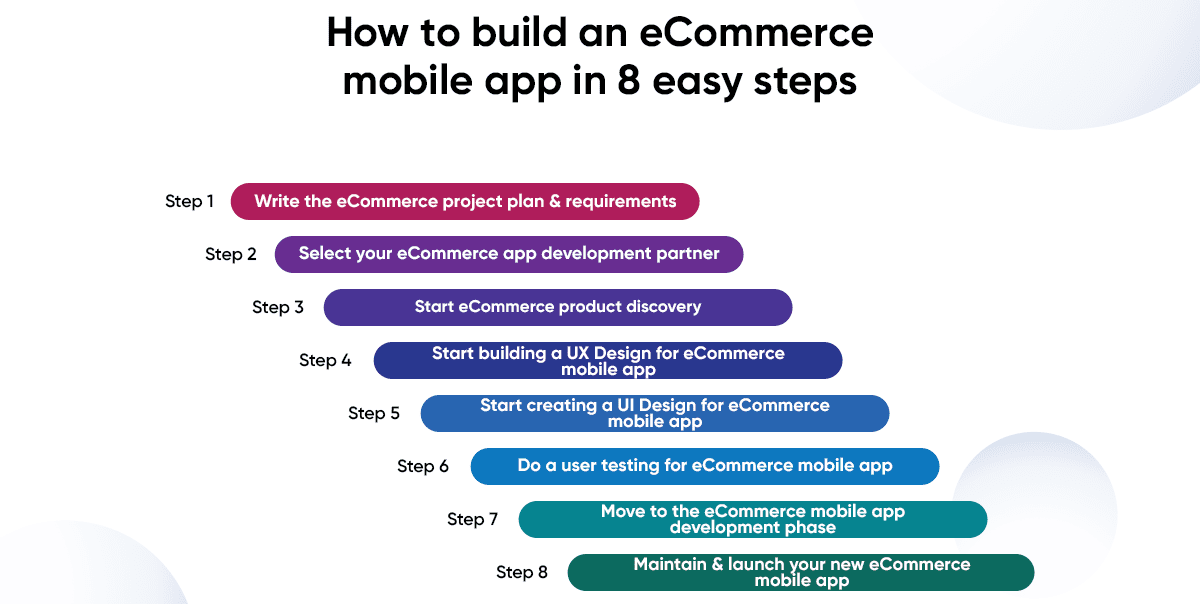

ecommerce app development process
Step1: Write the eCommerce project plan & requirements
The first step you need to start creating your eCommerce mobile application is writing a plan and requirements for your product. A plan is essential to keep the whole process organized and structured. By sticking to the plan, you will be able to complete the project faster and better.
The requirements for your product need to be written so that your design and development team understands exactly what they need to work on. Usually, the project requirements include the following things:
- Full project overview
- Main needs and goals
- Target audience
- Functional requirements and desired set of features
- Aesthetic aspects
- Non-functional details
- Recommendations and prohibitions
- Questions
Want to learn how to write a requirements document?
Step 2: Select your eCommerce app development partner
Next, you need to choose a good app development partner. A good and professional team is half the success of the project. There are several ways to find a team:
- Use social networks like LinkedIn.
- Rate a large number of teams on ranking sites like Clutch.co.
- Ask friends and colleagues about the possible experience of working with a great team.
- Choose RewiSoft for fruitful collaboration!
When choosing a partner for your project, make sure that the team has enough experience in developing mobile applications, uses modern technologies, knows the latest market trends, and knows how to work in a team.
If you are looking for a reliable team to create an eCommerce mobile application, contact us. We will be happy to discuss the details of your project.
Step 3: Start eCommerce product discovery
When we work on projects, we usually get involved at this stage. At this step, it is necessary to conduct a product discovery.
Product discovery is responsible for studying the target audience, their expectations and requirements. The main goal of product discovery is to get information that will help make a high-quality, fast and profitable product. At this stage, it is very important that the development team communicates with your in-house team.
At RewiSoft, product discovery consists of the following things:
- discussion of the project’s existing business processes or the concept of a future project, expectations, and wishes
- regarding the deadlines
- definition of the target audience
- competitive market analysis
- formulating solutions to business problems
- determination of the scope of work
- setting deadlines and priorities based on the project complexity and market trends
- schematic distribution of roles and appointment of specialists who should be involved in the process
At this stage, the following team members may be involved:
- the project/product manager
- business analyst or consultant/expert in a certain area
- UI/UX specialist
- solution architect or engineer
Step 4: Start building a UX Design for eCommerce mobile app
The goal of UX design is to create a digital product that the user will feel comfortable with. This includes how the product functions and the user manages it: content hierarchy, clear navigation, and the functionality of visual elements.
But the most important thing is that all this helps solve the user’s problem. In addition, the design should be created in accordance with technical and business specifications. Here are the steps that the UX design process usually consists of:
- Product definition
- Stakeholder interviews
- Value proposition mapping
- Concept sketching
- Research
- Individual in-depth interviews
- Competitive research
- Analysis
- Creating user personas
- Creating user stories
- Storyboarding
- Design
- Sketching
- Creating wireframes
- Creating prototypes
- Creating a design specification
- Creating design systems
- Validation
- Testing sessions
- Surveys
- Analytics
Step 5: Start creating a UI Design for eCommerce mobile app
UI design is the process of visualizing a prototype that was developed based on user experience and target audience research. UI design includes work on the graphic part of the interface: animation, illustrations, buttons, menus, sliders, photos and fonts.
UI design is responsible for how the product interface looks and how the user interacts with its elements. It is necessary to correctly organize the interface elements and maintain a single style and logic of their interaction. Your main task is to help the user understand how to use the product quickly and without stress. To do this, you should ensure that the interface meets the basic requirements.
Step 6: Do a user testing for eCommerce mobile app
After the design is completely ready, you can start testing. Never skip this step. The more detailed you test the product, the more likely your application will work like a Swiss watch.
Step 7: Move to the eCommerce mobile app development phase
Now comes the most crucial stage. You need to turn the design into a real working product and become closer to building an eCommerce app. To build eCommerce apps, RewiSoft team uses Agile Development Lifecycle Methodology. eCommerce app developers write code for all product components. The tasks are divided between the team members according to their area of specialization.
Front-end developers are responsible for the client side of the application. Back-end developers are responsible for API and database development. DevOps team working on the CI/CD process. QA engineers work on testing all delivered code and write automated tests for developed components.
Depending on the project’s scope of work, we assign 2+ eCommerce app developers to implement the server side of the application, APIs, and business logic and transform UI design into a functioning user side.
Step 8: Maintain & launch your new eCommerce app
At the final stage, you need to check the product for bugs and errors and fix everything that does not work as it should. When you are sure that your product functions as expected, you can move on to the launching stage. The product launch process causes meticulous preparation and should be carried out systematically to guarantee that clients accept the product favorably. The following are the major steps to start an eCommerce app:
- Target audience identifying
- Unique product packaging creation
- Slogan and timeline creation
- Competitors analysis
- Customer onboarding creation
- Website creation
- Advertising
Next, we recommend maintaining your eCommerce app and scaling it with new functionality.
How to Build an eCommerce Mobile App with RewiSoft
RewiSoft has great expertise in creating engaging eCommerce mobile applications that drive traffic, improve conversions and increase sales. Building eCommerce mobile apps, we provide the following:
- Flexibility & adaptability
- Operations
- Customization & personalization
- Security & compliance
One of our customers, Needl is a platform that creates business opportunities (leads) between buyers and sellers. It is currently working in the FMCG retail market (food, drinks, beauty) and is focused on reaching a good product-market fit.
When we started working with Needl, the platform was not aligned with Needl product new positioning (messages, graphics). Our partner was gaining to make the design elegant, modern and professional. They also wanted the platform to work smoothly with advanced functionality. After conducting several workshops with our customer and brainstorming sessions with our team, we identified several areas of work:
- Rebuild UI/UX design. We refreshed the logo and design system according to modern trends and industry features. We built out more user-friendly navigation and updated the UI/UX of the dashboard for 2 personas.
- Rebuild information architecture. In order for the product to work more logically and be scalable in the future, we rebuilt the information architecture of the application and organized the content in such a way that it would be easier for users to achieve their goals.
As a result, we helped align Needl’s positioning and created a modern and elegant platform design.
Another customer, Life Style Voucher, is an experienced and passionate bunch of reward and recognition experts with a real zest for life – making rewarding easy for all. The company has been achieving great results for its clients for over 15 years.
The RewiSoft team built a great eCommerce mobile application for this company that allows customers in a few clicks to start shopping using vouchers from over 120 of the UK’s best-loved brands.
We will help you find the best solution for your business.
Trends and Facts You Need to Know to Build an eCommerce App
How to build an eCommerce mobile app that will be in demand and popular? To begin with, we recommend that you study the trends of this market. Let’s look at the main ones in 2022.


ecommerce app development services and tips
Quick facts about eCommerce mobile applications
- 53% of smartphone users buy from branded apps
- The conversion from mobile apps is three times higher than from mobile sites.
- About 82% of internet users in the US use mobile devices to shop online.
- 45% of smartphone users plan to shop more on mobile apps in 2023.
- Mobile shoppers spend twice as much money as other shoppers.
- According to an eMarketer report, The Future of Retail, the growth of e-commerce will reach $845 billion in 2022.
Top trends in the eCommerce mobile app market
And before moving on from how to create eCommerce app to building an eCommerce mobile application, you should first find out the major trends in the eCommerce mobile app market:
Chatbots
Many well-known companies, such as Spotify or Lyft prefer to use chatbots to communicate with customers. According to some statistics, 54% of consumers prefer to contact sellers and brands using chatbots rather than phone calls. Chatbots make it possible to communicate with customers 24/7.
Also, because such modern technologies as AI and ML have become available, chatbots can receive and analyze customer data. This helps predict what next question, for example, the clients will ask and what better answer to give them.
Omnichannel marketing
As a major trend in modern eCommerce, the purpose of omnichannel marketing is to provide customers with chances for fulfillment from wherever they want to purchase. From smartphone to in-person purchasing, omnichannel marketing allows customers to interact with companies on their own terms via a single, convenient channel.
Personalization
To feel relevant nowadays, customers want much more than their name at the top of a marketing email. People want to be heard and want companies to provide them with information that is relevant to their needs – at the appropriate time and in the right location. Brands can guarantee customers see what they’re genuinely interested in by customizing their advertising with bespoke targeting, generating relevance, engagement, and conversions.
Voice assistants
Everyone knows the voice assistants Siri and Alexa. Voice search is very convenient in online shopping. According to some statistics, 51% of consumers use voice search to find the goods they need, and 22% to order.
Why Do You Need to Build the eCommerce Apps?
We have prepared some convincing facts for you. Let’s look at them in more detail, and you will know how to create an eCommerce app.
Always at the customer’s fingertips
Creating an eCommerce mobile application will make it possible for users to shop anytime, anywhere. Very often, people standing in lines or in traffic jams use their phones to pass the time. It would be great if, at that time, they could use the eCommerce mobile app to make the purchases they require.
High level of service offered
You automatically offer users a new level of service and a better one if you know how to create an eCommerce app. As a result, new opportunities open up for customers, namely, to buy goods and place orders online anywhere in the world and at any time.
Attracting a new audience
By opening up new opportunities for people, you attract a new audience. For example, young people prefer to use mobile phones more than computers because they are more convenient, faster, and more affordable.
Gaining clients trust
By offering people an eCommerce mobile app with a good security system, for example, you increase user trust in you. But the most important thing is the security system. Without it, it won’t be easy to prove to the user that your eCommerce mobile app is a safe place to shop and place orders.
A new level of communication
Mobile applications are always about fast and high-quality communication. If you know how to create an eCommerce app and build it, you can be with customers 24/7. This becomes a significant advantage.
Chance to expand business
By creating an eCommerce mobile application, you will automatically make an opportunity for the future growth of your business. Over time, you will be able to expand the capabilities of your application, thereby offering your users a more comprehensive range of services and better quality.
Additional marketing channel
By providing users with access to your business through a mobile application, you open up another marketing channel for your company, as well as increase the effectiveness of existing marketing. You also get extra space for ads, sales funnels, conversion strategies, etc.
Covid-19 and worldwide trends
With the advent of the Covid-19 pandemic, people have become more likely to shop online. Also, new trends began to appear related to the world’s transition to online mode. Therefore, switching to a mobile application will allow your business to be in trend and meet modern realities.
Design Challenges You May Face When Will Decide To Build an eCommerce Mobile App
How to build an eCommerce mobile app without any challenges? Actually, not at all. Any process, and especially the creation of a new product, includes several challenges. Let’s first look at the design challenges:
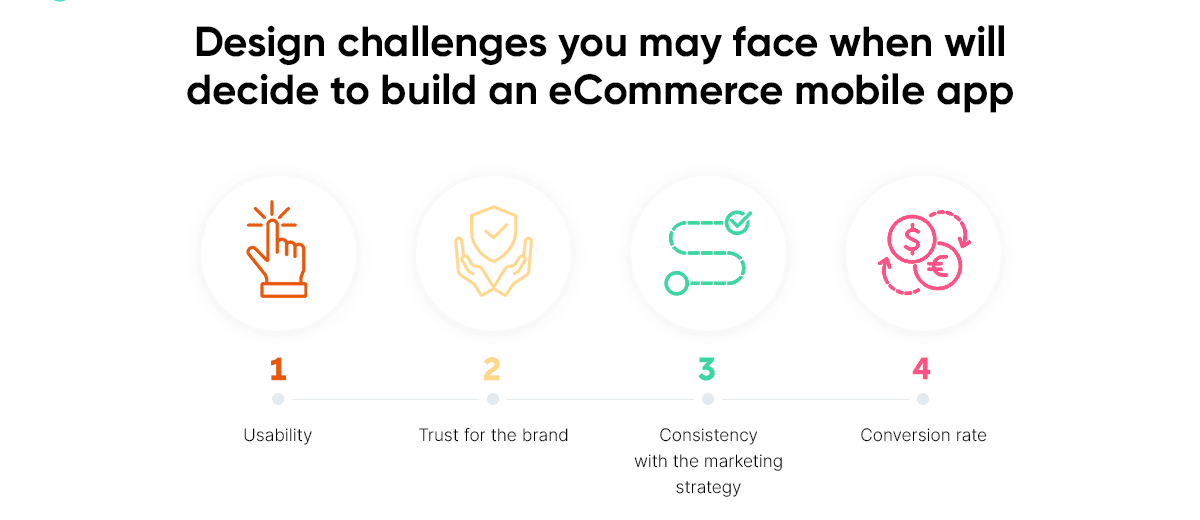

Design Challenges for an eCommerce app development company
Usability
The first thing you need to know in how to build an eCommerce mobile app is usability. To make the user experience of a mobile app truly seamless, everything from registration to checkout should work correctly. The usability is an essential part of the ecommerce application development and plays a vital role in creating an efficient and user-friendly user interface. If your application is useful and valuable to the users, but they absolutely do not understand how to use it, they will abandon it.
Trust for the brand
It is challenging to earn people’s trust. When creating an eCommerce mobile application, you may encounter this problem. We said earlier that nothing is more trustworthy than security. If users feel safe in your application and know that no one will steal their money, then they will definitely trust your business.
Consistency with the marketing strategy
Be sure to stick to your marketing strategy. If you don’t combine these two things, your eCommerce mobile app will certainly not work and deliver the results you expect. The more people you tell about your application, the more users you will get. Marketing is essential!
Conversion rate
This challenge is related to the previous point in a how to build an eCommerce mobile app question. The better you set up the promotion of your application through different marketing channels, the higher the conversion rate you will get. Usability and UX also affect the conversion rate. Different CTAs and appeals can significantly increase the conversion rate.
Development Challenges You May Face When Will Decide To Build an eCommerce Mobile App
Now let’s look at the difficulties that you may encounter during the development stage when solving a how to build an eCommerce mobile app question:
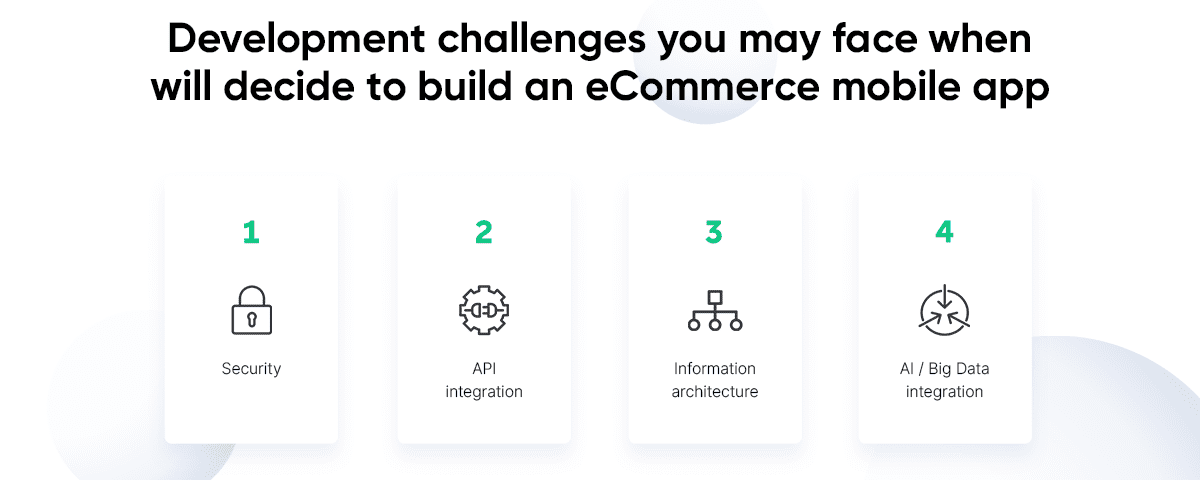

Challenges for a software development team
Security
Among mobile app leaders by a number of installs, 94% contain at least three medium-severity vulnerabilities, and 77% contain at least two critical vulnerabilities. Compared to other types of devices, mobile phones are the most at risk for theft or loss.
But even if the physical copy of the device is with the user, you should be more concerned about the proper level of storage of sensitive data (confidential information, etc.) to prevent intentional and unintentional leaks.
API integration
The potential of APIs in mobile applications is vast and valuable for any business. Here are just some of the features that can be implemented in an application using external interfaces:
- Authorization in the service through an account in social networks or a Google account;
- A variety of online client forms (filling out an order, managing a shopping cart, etc.);
- Currency converters and financial calculators;
- Chatbots and means of communication between the client and the support service;
- Integration of online maps;
- Use of electronic wallets;
- Mobile banking;
- AI tools (voice recognition, for example).
API tools help businesses quickly and cheaply automate routine processes and transform legacy web services and a very popular solution in a how to build an eCommerce app in android question. At the same time, the introduction of new technology with this approach will take only a few weeks.
Information architecture
It is crucial to make the product so that it can be scaled in the future. This is directly related to the future of your business. If you want to grow your business and open up new opportunities for your customers, you should make the product scalable. In order for a product to be scalable in the future, you need to think about its information architecture in advance.
It should be built in such a way that when changes are made to the product in the future, its functioning does not deteriorate. A well-built information architecture directly affects the user experience.
AI / Big Data integration
AI technologies will be widely used to analyze customer choice, automate, optimize resource usage, generate automatic responses to queries, and improve conversion rates. Based on the capabilities of AI and Big Data, users get a personalized experience. That is one of the key points in how to build an eCommerce app in android question.
With the help of Big Data analysis algorithms, specialists use statistics for further forecasting. Big Data algorithms also help identify the target audience, analyze user behavior, select key messages and track campaign results. In eCommerce mobile app development, AI helps analyze shopping behavior and increase sales by providing relevant product recommendations.
Technology plays an essential role in the personalization process. The most prominent example of an application that provides a personalized experience with the help of AI is My Starbucks. Users can order a drink on the go. The chatbot makes recommendations based on the preferences of the client. The user can place orders by voice via Amazon Alexa or through the MyBarista app and then receive them at a selected coffee shop nearby.
Core Features to Add to Your eCommerce Mobile App
And now, let’s look at the list of the main features that you should add to your eCommerce mobile application.
Personal account
A personal account is the heart of any eCommerce application. This feature should allow users to fill in personal details, view their shopping cart and purchase history, and generally make purchases or sales.
Apple Pay / Google Pay
Your eCommerce application should have the ability to pay for goods using Apple Pay or Google Pay. Today’s youth, for example, often use these payment methods.
Checkout process
Without this feature, users will not be able to use the primary purpose of the application – the purchase of goods. Therefore, it is very important to make this feature easy to use and understandable for the user.
Smart filters
This feature is needed so that users can quickly find the product they need. These filters should contain as many criteria as possible. The faster the user achieves the goal, the better the user experience will be.
Chatbot
As we mentioned earlier, chatbots are trending in 2022. Therefore, you should add a chatbot to your platform. It will help automate many processes and make communication with users better.
Reminder and notification system
This feature will help users to always be aware of what, for example, is happening with their order (the order is accepted, the order is being collected, the order has been sent). Of course, if users don’t want to receive notifications, they can always turn them off.
Discount system
This feature is one of the most attractive for users. It will allow, for example, people to buy goods with a particular discount for any holidays. Or let’s say you can make seasonal discounts for users. There are a lot of options for implementing this feature.
AR/VR Size Advisor
This feature greatly improves the user experience. Users will be able to try on any clothes, for example, without leaving their homes. They will only need to use the camera of their phone. This feature has already been implemented by many well-known brands such as Nike, Adidas, Hugo Boss, etc.
Biometric identification
To identify the user in the application, you can use biometrics – for example, scanners of the iris, facial geometry, or a fingerprint. The use of such technologies is now very popular.
Real-time information
This feature allows you to show information about the users’ orders in real-time. That is, each action that is carried out with the order will be displayed in the user’s personal account. For example, the goods were packed, the goods were sent, the goods are already in your city, etc.
The Best Tech Stacks to Build an eCommerce App
How to build an eCommerce mobile app that will work smoothly? The answer is to select the right tech stack. Let’s take a closer look.
How to build an ecommerce app on Android?
For the Android system, we advise your team to use the following for eCommerce mobile app development:
- Hybrid development: Flutter (budget-friendly development)
- Language: Java, Kotlin.
- Core: Android SDK, Android Jetpack.
- Analytics: Firebase, Amplitude, AppsFlyer, Facebook.
- Data: Realm, SQLite, Shared Preferences, Room.
How to build an ecommerce app in IOS?
Here is what we recommend to use for eCommerce mobile app creation for the IOS system:
- Language: Objective-C, Swift.
- Core: iOS SDK, CocoaTouch / Multimedia.
- Analytics: Firebase, Amplitude, AppsFlyer, Facebook.
- Data: Realm, CoreData, UserDefaults, KeyChain, CryptoSwift.
Custom eCommerce App Vs. Ready-Made Solution
If you’re going to build an application for your business, it’s best to go with a custom-built app for better long-term outcomes. Here are some of the reasons:
Custom-developed applications are exactly that: tailored to your company’s needs
If you choose a free or low-cost app builder, you will be severely limited in the colors, styles, and visuals used in the design. It won’t be easy to truly showcase your company and brand at their finest, as well as separate your brand from other businesses that have created their apps on the same platforms.
A custom-built app will give you complete control over the design and user experience, allowing you to stand out from the crowd.
There are no recurring expenses for custom-built apps
If you decide to invest in a custom-made app, there is only a one-time fee for the design and development of your app. Of course, you may update or add features to your app at a later date for a price, but unlike ready-made apps, you won’t be locked into membership costs.
Keep in mind that many free or low-cost app development platforms disable access to the app as soon as the membership is terminated, which means that all design and content is lost and should be recreated.
With a custom-built app, you can take advantage of increased promotion chances
You have total control over your custom-built application, and you can market it on the Google App Store if it is designed for the Android platform or in the Apple App Store if it is designed for iPhones and iPads. You may use paid advertising methods to bring visitors to your app’s website since you will have a dedicated homepage for your app.
You may also market your app through social media or by linking to it directly from your website. Moreover, there is a good probability that people will find your app by surprise through organic search. Unfortunately, if you choose a free or low-cost app creation platform, you may not have your own unique app URL and may not be able to advertise it directly.
Typically, these applications reside on the development platform’s own website, making them difficult to locate unless you tell your clients about them directly.
Custom-built applications can be scaled in the future
Since the custom-build application is developed entirely for you and your company, you can make changes to the product at any time. Let’s say you want to add more advanced features or improve the design. Using a ready-made product, you will not have such an opportunity, but in the case of a custom-built application, you can change and scale the product as you wish. It is impossible to build a large and high-quality product on WordPress, so we advise you to choose the custom creation option.
How Much Does It Cost to Build an eCommerce App
The cost of building an eCommerce mobile application may be estimated based on the scope of work, the development approach, the technology stack, and the team size chosen. The following are the average hourly rate for employing different specialists in various parts of the world:
The quality of services differs according to location as well. While US-based startups and organizations hire elite talent, demand remains far greater than supply.
As a result, daring businesses prefer to seek eCommerce mobile app development services from abroad. The majority of them discover that outsourcing to Eastern Europe provides the finest price/quality ratio.
We have also prepared prices for the most suitable tech stacks for building an eCommerce mobile application:
- Kotlin – $45-85+
- Swift – $50-90+
- Flutter – $50-95+
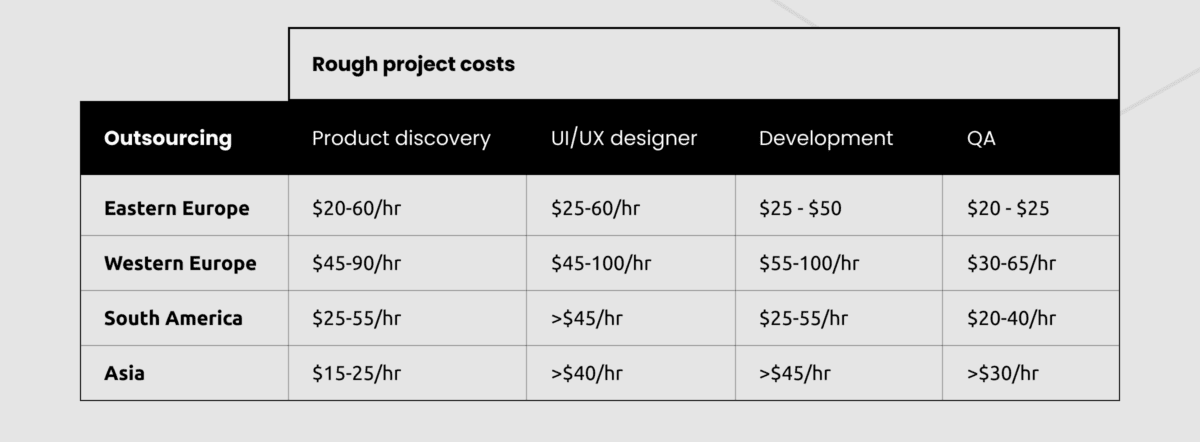

mobile ecommerce app estimation (costs)
How Much Does It Take to Build an eCommerce App
The time you need to build an eCommerce mobile app also largely depends on the size and complexity of your project, the amount of functionality, the complexity of the design, the experience of the development team, etc. To make it easier for you to calculate the approximate time required to build an eCommerce mobile app, we have compiled a table that shows the time required for each individual process of creating a product:
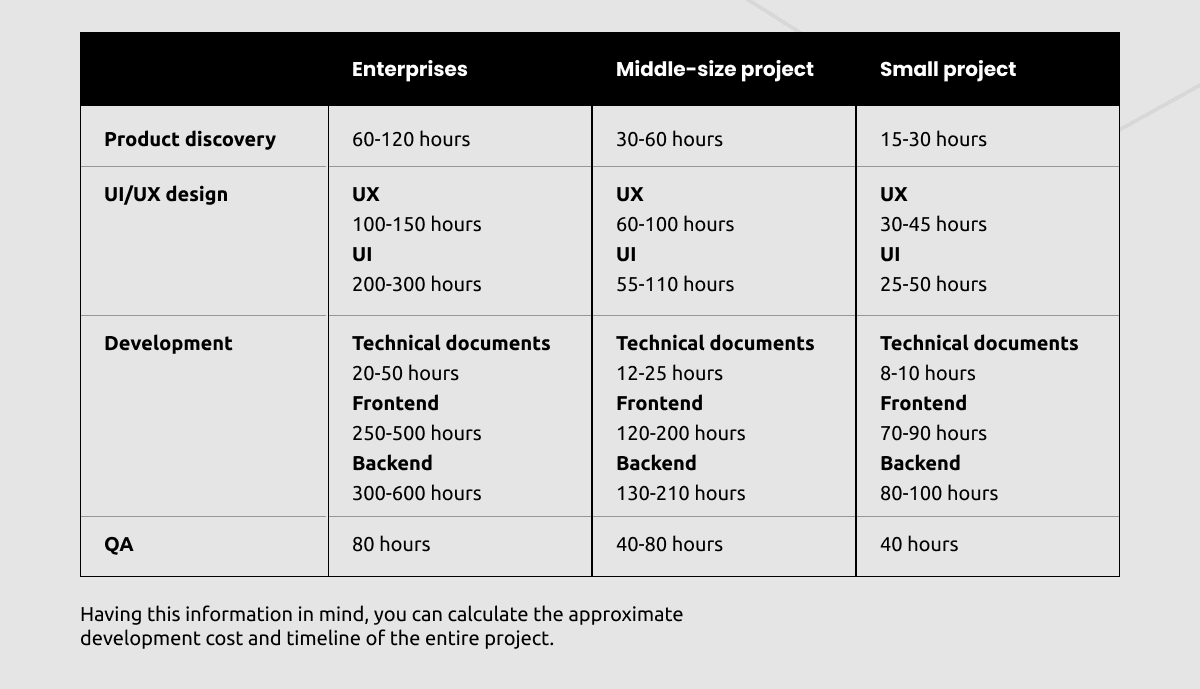

mobile e commerce app (development time)
How to Build the eCommerce Apps: Summary
Now you know how to create a successful eCommerce application for your business. To create a quality eCommerce mobile app, you need to study the market, trends, and challenges you may encounter.
Choosing a good and experienced design and development team is also very important. Remember that 50% of the success of your future product depends on the team. Also, do not forget about planning and the step-by-step process of creating a product (we described it in more detail in the guide).
You can always contact us if you need help creating a mobile eCommerce application.







